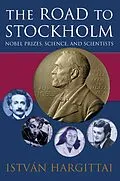The Nobel Prizes enjoy enormous prestige throughout the world. Every year, science is propelled into the limelight, and in October, when the prizes are announced, and December, when they are awarded at a ceremony in Stockholm, a chosen few scientists acquire celebrity status and their science receives wide coverage in the news media. First awarded in 1901, the Nobel Prize remains the only science prize widely recognized by the general public. What sort of scientists become Nobel laureates? How are they chosen? Are there features common to them, and to their prize-winning research? These sorts of questions have long intrigued István Hargittai and seeking answers, he began interviewing Nobel prize-winning scientists about their careers. Some 70 laureates, and a similar number of other distinguished scientists, have been interviewed, most of them during the late 1990s, and the result is this remarkable book. Written for a general readership, The Road to Stockholm illuminates the nature of scientific discovery, the Nobel Prize selection process, the factors common to award-winning research, and the effects of the Nobel Prize on science itself. Here are stories of scientists who overcame adversity, eventually to win the Prize; insights into the importance of the laureate's mentor in earlier life, and into the significance of the location where prize-winning research is carried out; and a variety of responses to the question: what first turned you to science? No less fascinating are the well-publicised examples of deserving (in many eyes) scientists who were not awarded the Nobel Prize, and Professor Hargittai devotes a chapter to them. Here, then, is an absorbing account of science, scientists, and a Prize created a hundred years ago to reward those who, in the words of Alfred Nobel's Will, 'during the previous year, shall have conferred the greatest benefit on mankind.'
Autorentext
István Hargittai is Professor of Chemistry of the Budapest University of Technology, and Economics and Research Professor of the Hungarian Academy of Sciences at Eötvös University. He has done research in molecular structures, lectured in 30 countries, and authored books on structural chemistry and symmetry-related topics, including Symmetry through the Eyes of a Chemist (with Magdolna Hargittai), second edition, Plenum; Symmetry: A Unifying Concept, Shelter Publ.; In Our Own Image: Personal Symmetry in Discovery (with Magdolna Hargittai), Kluwer/Plenum; and Candid Science: Conversations with Famous Chemists and Candid Science II: Conversations with Famous Biomedical Scientists, Imperial College Press. He is Editor-in-Chief of Structural Chemistry (Kluwer, New York).
Klappentext
The Nobel Prize is by far the highest recognition a scientist may receive and the only one with which the general public is familiar. Its prestige has reached improbable heights. At the same time a lot of myth surrounds the Nobel Prize, and this is compounded by the fact that people tend to view scientists with some bewilderment. This book introduces the process of selection of the laureates, discusses the ingredients for scientific discovery and for getting recognition. It reviews the decisive moments of scientific careers en route to the Nobel Prize, points to characteristic features of the laureates, the importance of mentors and venues in scientific careers and other components of success. It also covers some discoverers and discoveries for whom and for which the Nobel Prize never materialized. Whereas there is no general recipe for receiving the Nobel Prize, there are common features of successful scientific careers. The book reveals some information about the scientists' lives and careers that may guide other scientists in increasing their chances of becoming more effective and better recognized players - although it is not expected to help anyone to receive the Nobel Prize! For the general reader The Road to Stockholm reveals the human face of scientists and the human side of their endeavours. The Nobel Prize has served as inspiration for scientists and the general public for a hundred years: this book discusses its problems and celebrates its triumphs.
